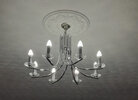All the time the manufacturers appear to be getting it wrong, what chance does Joe Public have?
This is a very real problem, maybe the USA use different words, even with ISO words and phrases the USA seem to ignore them and do there own thing, like low voltage (50 - 1000 VAC) and extra low voltage (under 50 volt AC), but first drivers I came across were for aircraft runway lamps, the transformer primaries were wired in series, so the output of each transformer would match, and every bulb would have same light output, and that is the problem with extra low voltage lamps, lights like this
with a 1 or 2 meter run are fine, but the tracks are very small, they have points where they can be cut and joined
but these can't really be used to extend the length, as the strip will not handle the current without some volt drop.
Wiring in series with a driver does reduce the volt drop problem, with DC low voltage starts at 75 volt, so most will be designed to work under that, and a typical white LED is 3 volt, so 25 LED's would be the max number, which is not really what is wanted. So my own display cabinet has three independent light strips

I changed the out ones,

for a longer set, (5 meters) centre still the original Lidi lamps, (3 meters) so 17 watt outer and 22 watt centre, and when set to full and white, they supplement the rooms lighting, for that size of room the non central chandelier is not enough

how the builders ever thought one ceiling light would be enough I don't know, the original 100 watt bulb was like a tocH candle in such a large room. (22x18 foot)
The switching on is easy, if you want more light, one can easy switch on an uplighter, or display lights, it is on leaving the room the problem arises, your left having to walk around the room, turning them all off, cure was to use smart lights, so 'hey google turn off living room lights' turns them all off, or on of course. I can also change how bright, and colour temperature and colour.
So I have to use the power supply which came with the lights, I did at one point use a smart socket with the original Ikea outer lights, but had to access the power supply to alter how bright or what colour, and power supplies on the top of the units out of view, so that was a pain.
Also often only use right hand side set, next to dinning table, so having them split into three works well.




